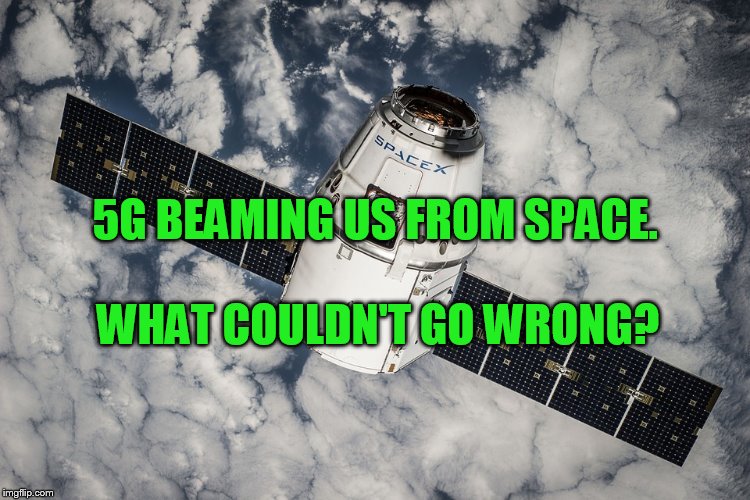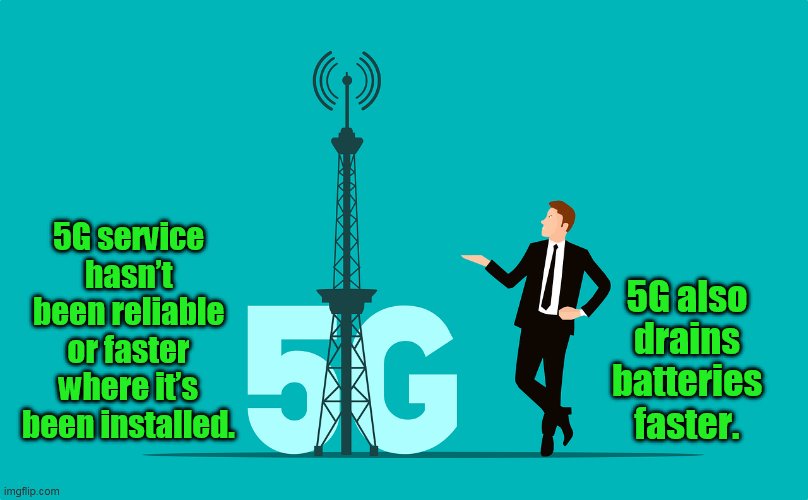 By B.N. Frank
By B.N. Frank
American opposition to 5G deployment has been ongoing for years due to various significant issues associated with it including aviation equipment interference risks (see 1, 2, 3). Of course, interference risks have not been isolated to aviation equipment. Utility companies and associations have filed lawsuits against the FCC in regard to interference risks from 5G deployment. Last week it was reported that The Department of Defense (DoD) has been trying to resolve potential 5G network interference issues with military radar. Additionally, last month telecom provider SpaceX started complaining that telecom provider Dish’s 5G satellites would cause interference issues affecting Starlink satellite service. Now DirecTV and RS Submit are also complaining about 5G interference risks.
From Fierce Wireless:
DirecTV, RS Access submit opposing studies in 12 GHz fight
It will be up to the FCC’s Office of Engineering and Technology (OET) to determine the direction for 12 GHz stakeholders. (Dish )
In a fight over 12 GHz that has seen the likes of SpaceX CEO Elon Musk tangle with Dish Network and other 5G stakeholders, more players are adding their voices to the chorus.
In the case of RS Access, which on July 15 submitted a new analysis responding to SpaceX/Starlink, it’s not a new voice by any means. RS Access has been involved in the proceeding for years, representing interests tied to Dell Technologies founder Michael Dell.
In the case of DirecTV, it’s also not exactly new to the party. But both are adding to the pile of studies, or “studies,” submitted into the record, depending on one’s interpretation of the word.
RS Access submitted an analysis by the engineering firm RKF Engineering Solutions. DirecTV commissioned a study by satellite and space consulting firm Savid LLC. SpaceX and OneWeb each undertook their own separate assessments, which show terrestrial 5G in the 12 GHz band would cause harmful interference to their satellite services.
Dish and RS Access insist the 12 GHz band can be shared with satellites and terrestrial 5G without harming incumbents, and their assessments prove the case for their arguments. Dish, which offers a satellite TV service using 12 GHz, believes 5G can co-exist in the band.
Related: Elon Musk’s Twitter withdrawal helps Dish’s efforts at 12 GHz: analysts
But according to the Savid report for DirecTV, mobile operations in the 12 GHz band would cause extensive harmful interference to DirecTV receivers, exceeding the limits currently in place to protect direct broadcast satellite (DBS) customers by a factor of 100 to 100,000 over areas extending well beyond the intended coverage area of the mobile base stations.
In a July 18 filing with the FCC, DirecTV, whose parent is AT&T, said high-power mobile communications can’t be introduced into the 12 GHz band without causing “significant and widespread harmful interference to millions of DirecTV subscribers across the country. DBS is a one-way service that cannot afford to lose packets to interference. Unlike broadband systems, which can replace lost packets through two-way communications, DBS packets lost to interference result in frozen video screens – and canceled subscriptions.”
RS Access refutes Starlink report
RS Access, in its most recent submission to the commission, responded with a supplemental report that sought to respond to Starlink’s examination of 5G and non-geostationary satellite orbit (NGSO) systems in the Las Vegas, Nevada, market and to identify factors driving the disparity between Starlink’s claims and the results of RKF’s prior studies.
According to RS Access, its report allows the FCC to review the two sets of assumptions side-by-side and decide which offers the most reasonable and accurate view of the system architectures, service models and radiofrequency propagation characteristics.
For its part, “RKF states that its review of the Starlink submission has only strengthened its confidence that 5G deployments will have no effect on at least 99.85% of NGSO operations in the 12 GHz band,” RS Access CEO V. Noah Campbell told the commission.
Multiple studies
It will be up to the FCC Office of Engineering and Technology (OET) to determine where it all goes – and ultimately, the commissioners on the FCC. They’re still in study mode on this one.
“The FCC has a phenomenal track record of determining conflicting engineering work and they’re highly capable of reviewing the technical record and determining the correct outcome,” Campbell told Fierce.
Chairwoman Jessica Rosenworcel said earlier this year that the agency had its best engineers working on the issues, which are among the most complex undertaken at the agency.
“Now that the FCC has been working on this, had their best engineers working on it for three and a half months and the record is complete from an engineering standpoint, we would expect meaningful feedback related to the state of the engineering analysis relatively soon,” Campbell said.
Dish and RS Access are members of the 5G for 12 GHz Coalition, which is throwing its full support behind the RKF study. The coalition includes 36 members, including public interest groups like Public Knowledge, the Benton Institute and OTI and broadband companies that are deploying fiber, fixed and 5G networks across the U.S.
“This study, like the others coalition members have previously submitted into the docket, is based on sound science and data that clearly demonstrates coexistence is feasible among two-way terrestrial, mobile 5G, and NGSO users without significant harmful interference,” the coalition said in a statement.
The coalition reiterated that the 12 GHz band – with 500 MHz of contiguous spectrum – is one of the most promising opportunities for next-generation connectivity.
“The coalition believes in the power of this band for all Americans – not just in supporting one business model or one type of service provider. We urge the FCC to complete its analysis of coexistence in the band, and are confident that the data and science, including this new filing, will provide the commission with the evidence it needs to confirm that opening up this critical spectrum for 5G is not only possible but in the public interest,” the organization said.
Despite interference issues as well as additional known risks, the Federal Communications Commission (FCC)(see 1, 2, 3, 4, 5, 6, 7, 8) and other government and state agencies and committees (see 1, 2, 3, 4, 5, 6, 7) have continued to promote and fund 5G deployment and densification as well as that of 4G and public Wi-Fi (which also poses known risks). American businesses hospitals, and school districts (see 1, 2) continue to install 5G and other wireless infrastructure for “private networks” as well.
The FCC is supposed to protect Americans by regulating the telecom industry. It has failed to do so for decades (see 1, 2) and that has led to several lawsuits filed against the agency. In 2021, a federal court ruled in favor of organizations and petitioners that sued the FCC for NOT adequately protecting Americans from wireless radiation exposure from 5G and other sources of wireless. Also in 2019, telecom executives gave congressional testimony that they had NO independent scientific evidence that 5G is safe.
Opposition to 5G is worldwide which has limited, slowed, and/or stopped deployment in some locations (see 1, 2). Since 2017 doctors and scientists have asked for moratoriums on Earth and in space (see 1, 2) and the majority of scientists oppose deployment. Since 2018 there have been reports of people and animals experiencing symptoms and illnesses after it was activated (see 1, 2. 3, 4, 5). Some researchers have suggested that 5G activation may be contributing to COVID-19 infections as well as hundreds of thousands if not millions of bird deaths. Of course, there are health risks associated with 4G and other sources of wireless Wi-Fi radiation (see 1, 2) and electromagnetic fields (aka “Electrosmog”) which may be contributing to symptoms and illnesses as well.
Last but not least, 5G service continues to receive really bad reviews (see 1, 2, 3, 4, 5, 6, 7, 8, 9). Regardless, 5G doesn’t seem to be the end goal anyway – it’s 6G which isn’t without risk either.
Activist Post reports regularly about 5G and other unsafe technology. For more information visit our archives and the following websites.
- Americans for Responsible Technology
- Electromagnetic Radiation Safety
- Environmental Health Trust
- Physicians for Safe Technology
- 5G Free
- 5G Information
- Wireless Information Network
Become a Patron!
Or support us at SubscribeStar
Donate cryptocurrency HERE
Subscribe to Activist Post for truth, peace, and freedom news. Follow us on SoMee, Telegram, HIVE, Flote, Minds, MeWe, Twitter, Gab, What Really Happened and GETTR.
Provide, Protect and Profit from what’s coming! Get a free issue of Counter Markets today.


Be the first to comment on "AT&T’s DirecTV and RS Submit Opposing 5G Studies in re “harmful interference to their satellite services”"